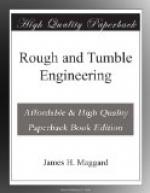The expert brings his engine back under full control, and stops it exactly where he wants it. He handles his engine with his head and should be paid accordingly. He never makes a false move, loses no time, breaks nothing, makes no unnecessary noise, does not get the water all stirred up in the boiler, hooks up and moves out in the same quiet manner, and the onlookers think he could pull two such loads, and say he has a great engine, while the engineer of muscle would back up and jerk his engine around a half dozen times before he could make the coupling, then with a jerk and a snort he yanks the separator out of the holes, and the onlookers think he has about all he can pull.
Now these are facts, and they cannot be put too strong, and if you are going to depend on your muscle to run your engine, don’t ask any more money than you would get at any other day labor.
You are not expected to become an expert all at once. Three things are essential to be able to handle a traction engine as it should be handled.
First, a thorough knowledge of the throttle. I don’t mean that you should simply know how to pull it open and shut it. Any boy can do that. But I mean that you should be a good judge of the amount of power it will require to do what you may wish to do, and then give it the amount of throttle that it will require and no more. To illustrate this I will give an instance.
An expert was called a long distance to see an engine that the operator said would not pull its load over the hills he had to travel.
The first pull he had to make after the expert arrived was up the worst hill he had. When he approached the grade he threw off the governor belt, opened the throttle as wide as he could get it, and made a run for the hill. The result was, that he lifted the water and choked the engine down before he was half way up. He stepped off with the remark, “That is the way the thing does.” The expert then locked the hind wheels of the separator with a timber, and without raising the pressure a pound, pulled it over the hill. He gave it just throttle enough to pull the load, and made no effort to hurry ii, and still had power to spare.
A locomotive engineer makes a run for a hill in order that the momentum of his train will help carry him over. It is not so with a traction and its load; the momentum that you get don’t push very hard.
The engineer who don’t know how to throttle his engine never knows what it will do, and therefore has but little confidence in it; while the engineer who has a thorough knowledge of the throttle and uses it, always has power to spare and has perfect confidence in his engine. He knows exactly what he can do and what he cannot do.
The second thing for you to know is to get onto the tricks of the steer wheel. This will come to you naturally, and it is not necessary for me to spend much time on it. All new beginners make the mistakes of turning the wheel too often. Remember this-that every extra turn to the right requires two turns to the left, and every extra turn to the left requires two more to the right; especially is this the care if your engine is fast on the road.




